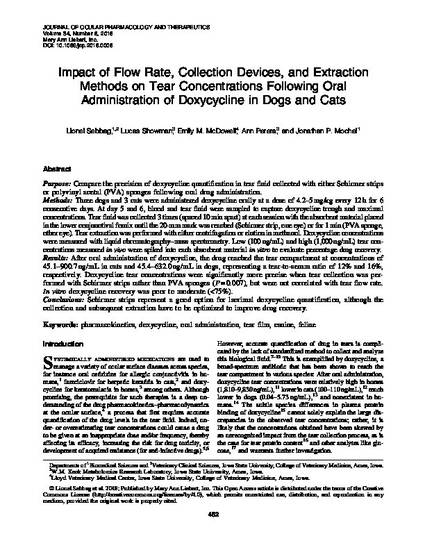
Purpose: Compare the precision of doxycycline quantification in tear fluid collected with either Schirmer strips or polyvinyl acetal (PVA) sponges following oral drug administration.
Methods: Three dogs and 3 cats were administered doxycycline orally at a dose of 4.2–5 mg/kg every 12 h for 6 consecutive days. At day 5 and 6, blood and tear fluid were sampled to capture doxycycline trough and maximal concentrations. Tear fluid was collected 3 times (spaced 10 min apart) at each session with the absorbent material placed in the lower conjunctival fornix until the 20-mm mark was reached (Schirmer strip, one eye) or for 1 min (PVA sponge, other eye). Tear extraction was performed with either centrifugation or elution in methanol. Doxycycline concentrations were measured with liquid chromatography–mass spectrometry. Low (100 ng/mL) and high (1,000 ng/mL) tear concentrations measured in vivo were spiked into each absorbent material in vitro to evaluate percentage drug recovery.
Results: After oral administration of doxycycline, the drug reached the tear compartment at concentrations of 45.1–900.7 ng/mL in cats and 45.4–632.0 ng/mL in dogs, representing a tear-to-serum ratio of 12% and 16%, respectively. Doxycycline tear concentrations were significantly more precise when tear collection was performed with Schirmer strips rather than PVA sponges (P = 0.007), but were not correlated with tear flow rate. In vitro doxycycline recovery was poor to moderate (<75%).
Conclusions: Schirmer strips represent a good option for lacrimal doxycycline quantification, although the collection and subsequent extraction have to be optimized to improve drug recovery.
Available at: http://works.bepress.com/jonathan-mochel/31/

This article is published as Sebbag, Lionel, Lucas Showman, Emily M. McDowell, Ann Perera, and Jonathan P. Mochel. "Impact of Flow Rate, Collection Devices, and Extraction Methods on Tear Concentrations Following Oral Administration of Doxycycline in Dogs and Cats." Journal of Ocular Pharmacology and Therapeutics 34, no. 6 (2018): 452. DOI: 10.1089/jop.2018.0008. Posted with permission.